The U.S. Navy Is Sending Virginia-Class Submarines to China's Doorstep

Summary and Key Points: The U.S. Navy is relocating the USS Minnesota (SSN-783), a Virginia-class fast attack submarine, from Hawaii to Guam, reinforcing its presence in the Indo-Pacific amid rising tensions with China.

-The deployment of this nuclear-powered submarine to Guam, part of the strategic second island chain, aims to counter China’s maritime activities in the region. The USS Minnesota, which recently completed extensive maintenance, will enhance the U.S. Navy's capabilities in sea control, power projection, and deterrence.
-This move underscores the U.S. commitment to maintaining stability and security in the Indo-Pacific.
U.S. Navy to Deploy Virginia-class Submarine in Guam
The Hub of the Pacific will soon be the homeport for a submarine named after the Land of 10,000 Lakes.
The U.S. Navy is adding to its submarine squadron on the U.S. territory of Guam. USS Minnesota (SSN-783), the 10th and final Block II Virginia-class fast attack submarine, is now scheduled to change homeport from Hawaii to Guam.
The nuclear-powered, conventionally armed cruise missile submarine is being deployed to counter China's naval buildup and expanded operations in the Indo-Pacific. The submarine recently completed an extended docking selected restricted availability (EDSRA) at Pearl Harbor Naval Shipyard and Intermediate Maintenance Facility. It began sea trials in June.
"During the maintenance period, the shipyard and crew performed tank blasting and coating, hull preservation, propulsion and ship system repairs, modernization upgrades and made enhancements to mechanical and electrical systems. Following certification, the crew will work together to maintain readiness and is scheduled to homeport shift to Guam later in the year," the U.S. Navy announced earlier this year.
Heading to the Second Island Chain
Beginning on Oct. 1, SSN-783 will be homeported from Guam, part of the second island chain that stretches from Japan to Micronesia. The first island chain includes the Kuril Islands, the main Japanese archipelago, and Taiwan, while it also stretches to the northern Philippines and the Malay Peninsula.
A concern for Washington has been China's gray zone operations in the first island chain. By maintaining a strong presence in the second island chain, the U.S. seeks to ensure Beijing doesn't take control of the Indo-Pacific in a time of war. The deployment of a Virginia-class submarine is meant as a defensive measure.

"The Navy routinely assesses its overseas force positioning, to include forward-deployed naval force submarines homeported in Guam," Lt. Cmdr. Rick Moore, a spokesperson for the U.S. Pacific Fleet commander's principal adviser on submarine affairs, told Newsweek. "We are committed to posturing our most capable platforms to preserve peace and stability in the Indo-Pacific region."
Guam is the westernmost territory of the United States, located just 1,500 to 1,700 miles from the Taiwan Strait and sitting near the contested waters of the East and South China Seas, the magazine also noted. The last homeport change for USS Minnesota was in March 2022, when the boat was redeployed from Groton, Connecticut, to Pearl Harbor.
The Virginia-Class in the Crosshairs
The U.S Navy's Virginia-class submarines first entered service in 2004, replacing the aging Cold War-era Los Angeles class. The Virginia was designed to incorporate the latest advances in stealth and weapons systems. The boats can handle a variety of open-ocean and littoral missions, including anti-submarine warfare as well as intelligence gathering. There are currently 22 Virginia-class submarines in active service out of the originally planned 66 boats – with current plans for the Navy to acquire at least an additional 30.
The nuclear-powered boats support five of the U.S. Navy's six core strategic maritime capabilities, including sea control, power projection, forward presence, maritime security, and deterrence. They do this through a combination of stealth, endurance, mobility, and firepower. The Virginia class remains the primary submarine for land, surface warfare, and anti-submarine attack missions, while its armaments include cruise missiles and torpedoes.
These SSNs have a fly-by-wire ship control system that provides improved shallow-water ship handling. The subs were also designed to deploy special operator forces including Navy SEALS. A reconfigurable torpedo room can accommodate a large number of SOFs and all their equipment for prolonged deployments and future off-board payloads.
The Third Vessel Named for Minnesota
SSN-783 is just the third U.S. Navy vessel to be named for Minnesota. The first was a wooden steam frigate launched in December 1855, when Minnesota was still a territory. The name for both the state and warship comes from a Lakota (Sioux) word that means "sky-tinted water."
The old frigate served with the U.S. Navy's East India Squadron and sailed some of the same waters the current USS Minnesota could call her stomping grounds. That first USS Minnesota saw service during the American Civil War and was damaged at the Battle of Hampton Roads – the historic showdown between the ironclads USS Monitor and CSS Virginia (aka Merrimack). Repaired and returned to duty, USS Minnesota later took part in the Second Battle of Fort Fisher. She was retired from service and burned as scrap to recover her iron fittings in 1901.

The second USS Minnesota (BB-22) was a 16,000-ton Connecticut-class pre-dreadnought battleship that served with the U.S. Navy's Great White Fleet, circumnavigating the globe in 1908-1909. It later was employed as a training ship during the First World War until being damaged after striking a German naval mine in September 1918. After repairs, her final duty was returning American soldiers from Europe after the end of the war. She was broken up in 1924.
Author Experience and Expertise: Peter Suciu
Peter Suciu is a Michigan-based writer. He has contributed to more than four dozen magazines, newspapers, and websites with over 3,200 published pieces over a twenty-year career in journalism. He regularly writes about military hardware, firearms history, cybersecurity, politics, and international affairs. Peter is also a Contributing Writer for Forbes and Clearance Jobs. You can follow him on Twitter: @PeterSuciu. You can email the author: Editor@nationalinterest.org.
All images are Creative Commons and/or Shutterstock.
